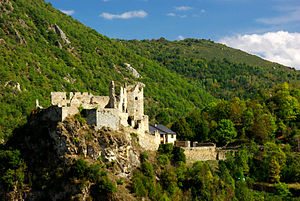Usson Castle
| Usson Castle | ||
|---|---|---|
|
Ruins of Usson Castle |
||
| Alternative name (s): | Castèl de So | |
| Creation time : | First mentioned in 1035 | |
| Castle type : | Höhenburg, summit location | |
| Conservation status: | ruin | |
| Standing position : | Cathars | |
| Place: | Rouze | |
| Geographical location | 42 ° 44 '8 " N , 2 ° 5' 14.6" E | |
| Height: | 920 m | |
|
|
||
The Castle Usson (French: Château d'Usson ; Occitan : Castèl de Sun ) is a ruined castle in the department of Ariege in the southern French region of Occitania . It is the southernmost of the Cathar castles in the south of France and has been recognized as a monument historique since 1978 .
location
The ruin of the summit castle is located on a rock peak at about 920 meters above sea level. d. M. above the valley of the river Aude in the area of the commune of Rouze, only a good two kilometers away, in the north of the small region of the Donetsan in the area of the upper Ariège valley. The next bigger town is Ax-les-Thermes , about 33 kilometers to the west ; the castles of Montségur , Puilaurens , Puivert and Quéribus are all within a radius of about 60 kilometers.
history
The castle was first mentioned in 1035, but its origins probably go back to the 10th or early 11th century; in the 12th century it formed the eastern border of County Foix and belonged to the So and Alion families . In the years after the end of the Albigensian Crusade (1209-1229), the Cathar bishop Guilhabert de Castres is said to have stayed here for a while, in the early 1240s she formed the last support of the Cathars who fled to Montségur Castle, who from here with weapons and food were supplied. On March 15, 1244, one day before the pyre was lit on the Montségur, six Cathars escaped to Usson, where the alleged treasure is said to have been taken a few months earlier. Bernard d'Alion, the last lord of the castle, was captured in 1257 or 1258 and burned in Perpignan after an inquisition trial.
The castle later played a role as a border fortress in the ongoing territorial disputes between France and Spain, which ended with the Peace of the Pyrenees (1659) and the marriage of Louis XIV to Maria Teresa of Spain (1660).
sightseeing
The old walls of the castle ruins have their charm - even if it is not clear in which period of the Middle Ages you are currently. More informative, however, is a small museum in the immediate vicinity of the castle, in which original finds as well as reconstruction drawings etc. are presented.
See also
Web links
- Château d'Usson - photos + information (French)
- Château d'Usson - photos + information (French)
Individual evidence
- ↑ Château d'Usson-les-Bains, Rouze in the Base Mérimée of the French Ministry of Culture (French)

